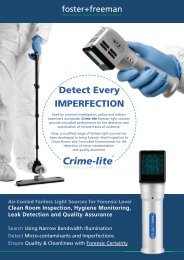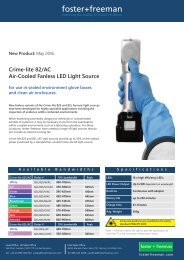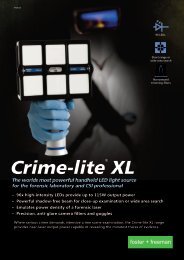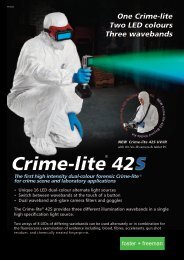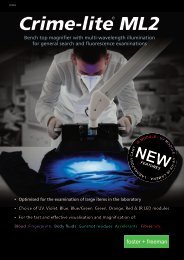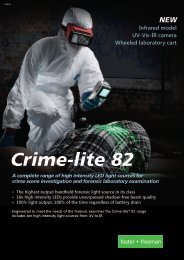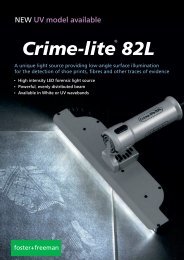ffTA a Workstation for Trace Evidence Analysis
The ffTA is a powerful and flexible multi-functional system that provides the crime laboratory with a range of analytical facilities on a single microscope operated through a single PC.
The ffTA is a powerful and flexible multi-functional system that provides the
crime laboratory with a range of analytical facilities on a single microscope
operated through a single PC.
Create successful ePaper yourself
Turn your PDF publications into a flip-book with our unique Google optimized e-Paper software.
POLARISED LIGHT MICROSCOPY <strong>for</strong> the analysis and identification of fibres<br />
<strong>ffTA</strong> TM PLM<br />
Light Polarisation Module<br />
Possibly the most widely used application <strong>for</strong> microscopy<br />
in <strong>for</strong>ensic science, Polarised Light Microscopy (PLM) is a<br />
valuable tool <strong>for</strong> the detection and analysis of small<br />
unknown particles and <strong>for</strong> the identification of fibres.<br />
A contrast-enhancing technique, PLM uses the birefringent<br />
properties of materials to improve the quality of the images<br />
obtained with the microscope.<br />
The addition of a 360-degree circular rotating specimen<br />
stage enables the user to make accurate measurements of<br />
a sample’s birefringence and to quickly identify fibres as<br />
acetate, acrylic, nylon, or polyester.<br />
<strong>Evidence</strong> identified by its birefringence<br />
Birefringence is the decomposition of a single ray of light into two separate rays<br />
as it passes through birefingent materials. By taking a measurement of the<br />
samples diameter and the colour retardation of the decomposed light, unknown<br />
materials can be identified against the interference colour chart.<br />
The <strong>ffTA</strong> TM Light Polarisation Module consists of a linear polariser mounted on<br />
the condenser lens, a second polariser (the analyser) placed in the optical<br />
pathway be<strong>for</strong>e the observation tubes and camera, and a retardation plate to<br />
enhance optical path differences between the cross-polarisers.<br />
Specimens are placed on a 360-degree circular rotating specimen stage<br />
equipped with two Vernier scales so that rotation angle can be measured to an<br />
accuracy of 0.1 degree.<br />
Cross-polar examination of a fibre<br />
<strong>ffTA</strong> TM PLM Module includes<br />
Interference Colour Chart<br />
360 o rotary polarisation stage<br />
• Ball bearing stage with locking clamp<br />
• Stage bracket and condenser holder.<br />
• Stage diameter 178mm<br />
• XY object guide<br />
Microscope Objective<br />
• Hi Plan x63 Polarisation Objective<br />
Polariser<br />
• 52mm mounted linear polariser<br />
• mounted analyser<br />
• 1 x waveplate<br />
• 1 x quarter waveplate<br />
Interference Colour Chart<br />
• Michel-Lévy table of birefringence<br />
Each <strong>ffTA</strong> TM<br />
PLM Module is supplied<br />
with a copy of the Michel-Lévy table of<br />
birefringence.<br />
In use <strong>for</strong> more than 100 years, the<br />
chart enables PLM examiners to<br />
identify fibres and minerals by<br />
measurement of a samples thickness<br />
and colour retardation.




